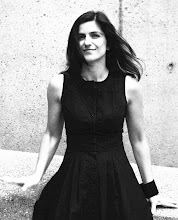from performance to architecture: Marina Abramovic part 1
In the beginning of March, at Harvard GSD, Sanford Kwinter hosted performer Marina Abramovic & architect Shohei Shigematsu (OMA NY) to present the Marina Abramović Institute. Kwinter acknowledged Abramović, as the spiritual founder of performance art practice. By borrowing some Nietzschean concerns and Spinoza's question, "What can a body do", he introduced to the audience the idea of thinking The Institute (i.e. building) as a body in extreme spatial temporal extension, as a kind of organism, that has the capacity to shape our experience, perception, and imagination. By exchanging the word body with that of building in Spinoza's question, Kwinter answered it at the end of his introduction: [the building]... "to alter the body and mind."
Shohei Shigematsu, described the Marina Abramović type of performance through the concept of "loose engagement." You can always stay connected to it, even if you are not the immediate audience. He compared this engagement looseness as similar to that one can find in baseball: he particularly mentioned how important it is even when you buy your hot dog to still be engaged with the act. He expanded this notion, also found in the semi-enclosed ciricle in the photo above, to that of an onion relationship, where the mulitple rings/ layers represent audiences with different degrees of engagement.
The building that Marina Abramović bought had been initially a community theater, but recently it has been transformed to an interior tennis court. OMA's proposal for the existing building, being based on this idea of "loose engagement," would require the creation of a very simple pure box in the middle of the building for different types of performances, around which they would position supplementary programs. The focus of the intervention has been the "audience 2m" second layer in the onion diagram, that would circulate in this additional programs (this is based on the assumption that the "audience 1," first layer in the onion diagram, would be fully engaged by default.
The building that Marina Abramović bought had been initially a community theater, but recently it has been transformed to an interior tennis court. OMA's proposal for the existing building, being based on this idea of "loose engagement," would require the creation of a very simple pure box in the middle of the building for different types of performances, around which they would position supplementary programs. The focus of the intervention has been the "audience 2m" second layer in the onion diagram, that would circulate in this additional programs (this is based on the assumption that the "audience 1," first layer in the onion diagram, would be fully engaged by default.
 Between "audience 1" and "audience 2," or between program: performance and additional programs respectively, OMA designed a wall, that acts as viewing window, it is like the section (wall) in a doll house. This kind of "loose engagement" has been present in many of OMA buildings (e.g. MTCC at IIT campus) so it is interesting to see how the architects use Abramović's as an alibi for their "agenda" or visionary architecture.
Between "audience 1" and "audience 2," or between program: performance and additional programs respectively, OMA designed a wall, that acts as viewing window, it is like the section (wall) in a doll house. This kind of "loose engagement" has been present in many of OMA buildings (e.g. MTCC at IIT campus) so it is interesting to see how the architects use Abramović's as an alibi for their "agenda" or visionary architecture.
"The Abramović method" has been the second ("Loose engagment has been the first) out of three notions the architects took under consideration. In the above diagram one can see the translation of the method to that (red) circuit one needs to follow when entering the building. As one understands through the progression of this lecture by both Sho (hei) and Marina, the new audience follows this script, that acts as a learning experience, a (desired) training for performance art. 


The third notion they took into consideration has been the chair. Since in Abramovic &'s performances long duration has been very important concept (Time for Abramović is crucial in performance) the Institute should provide the right chairs for all the different types of audiences. Comfort, relaxation, and even sleep is necessary to make you forget, and concentrate in the present. Sleeping is in fact another form of engagement.
During the wheeled chair experience, but also in other parts of the Abramović's method, it is hard to distinguish who is the audience. There are multiple audiences, like one audience that observes the audience who observes the performance and so on.
According to Shigematsu, OMA realized that with Marina Abramović everything becomes a performance. In order to address this issue of constant observation they made a hole into the Institute model through which one can "observe" what happens inside: you need to "wear" it and therefore you perform. In this case the observation of the model becomes part of the performance.

This model attracted a lot of attention during the fundraising event, where as Shigematsu said, they did enjoy being stuck in the model. (to continue reading click PART 2)
Labels: events, gsd, lectures, performance












0 Comments:
Post a Comment
<< Home